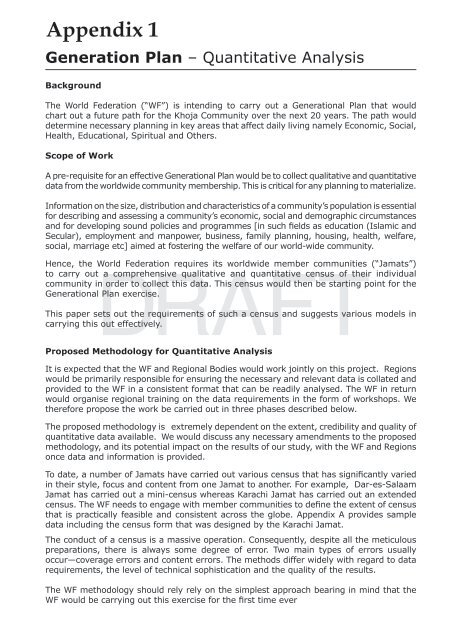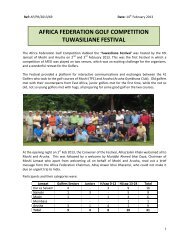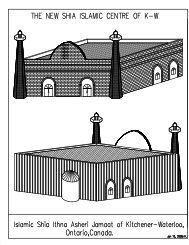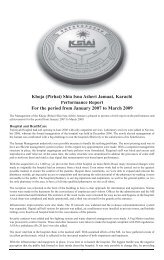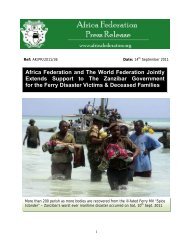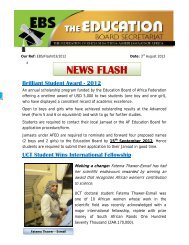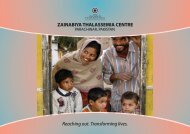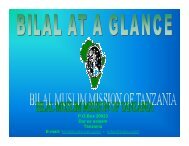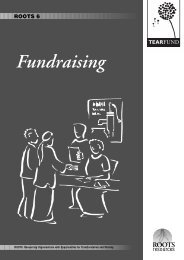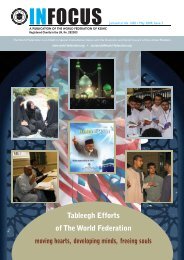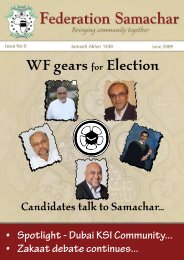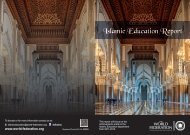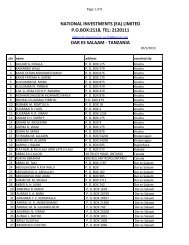Generation Plan Appendix 1 - The World Federation of KSIMC
Generation Plan Appendix 1 - The World Federation of KSIMC
Generation Plan Appendix 1 - The World Federation of KSIMC
Create successful ePaper yourself
Turn your PDF publications into a flip-book with our unique Google optimized e-Paper software.
<strong>Appendix</strong> 1<br />
<strong>Generation</strong> <strong>Plan</strong> – Quantitative Analysis<br />
Background<br />
<strong>The</strong> <strong>World</strong> <strong>Federation</strong> (“WF”) is intending to carry out a <strong>Generation</strong>al <strong>Plan</strong> that would<br />
chart out a future path for the Khoja Community over the next 20 years. <strong>The</strong> path would<br />
determine necessary planning in key areas that affect daily living namely Economic, Social,<br />
Health, Educational, Spiritual and Others.<br />
Scope <strong>of</strong> Work<br />
A pre-requisite for an effective <strong>Generation</strong>al <strong>Plan</strong> would be to collect qualitative and quantitative<br />
data from the worldwide community membership. This is critical for any planning to materialize.<br />
Information on the size, distribution and characteristics <strong>of</strong> a community’s population is essential<br />
for describing and assessing a community’s economic, social and demographic circumstances<br />
and for developing sound policies and programmes [in such fields as education (Islamic and<br />
Secular), employment and manpower, business, family planning, housing, health, welfare,<br />
social, marriage etc] aimed at fostering the welfare <strong>of</strong> our world-wide community.<br />
DRAFT<br />
Proposed Methodology for Quantitative Analysis<br />
Hence, the <strong>World</strong> <strong>Federation</strong> requires its worldwide member communities (“Jamats”)<br />
to carry out a comprehensive qualitative and quantitative census <strong>of</strong> their individual<br />
community in order to collect this data. This census would then be starting point for the<br />
<strong>Generation</strong>al <strong>Plan</strong> exercise.<br />
This paper sets out the requirements <strong>of</strong> such a census and suggests various models in<br />
carrying this out effectively.<br />
It is expected that the WF and Regional Bodies would work jointly on this project. Regions<br />
would be primarily responsible for ensuring the necessary and relevant data is collated and<br />
provided to the WF in a consistent format that can be readily analysed. <strong>The</strong> WF in return<br />
would organise regional training on the data requirements in the form <strong>of</strong> workshops. We<br />
therefore propose the work be carried out in three phases described below.<br />
<strong>The</strong> proposed methodology is extremely dependent on the extent, credibility and quality <strong>of</strong><br />
quantitative data available. We would discuss any necessary amendments to the proposed<br />
methodology, and its potential impact on the results <strong>of</strong> our study, with the WF and Regions<br />
once data and information is provided.<br />
To date, a number <strong>of</strong> Jamats have carried out various census that has significantly varied<br />
in their style, focus and content from one Jamat to another. For example, Dar-es-Salaam<br />
Jamat has carried out a mini-census whereas Karachi Jamat has carried out an extended<br />
census. <strong>The</strong> WF needs to engage with member communities to define the extent <strong>of</strong> census<br />
that is practically feasible and consistent across the globe. <strong>Appendix</strong> A provides sample<br />
data including the census form that was designed by the Karachi Jamat.<br />
<strong>The</strong> conduct <strong>of</strong> a census is a massive operation. Consequently, despite all the meticulous<br />
preparations, there is always some degree <strong>of</strong> error. Two main types <strong>of</strong> errors usually<br />
occur—coverage errors and content errors. <strong>The</strong> methods differ widely with regard to data<br />
requirements, the level <strong>of</strong> technical sophistication and the quality <strong>of</strong> the results.<br />
<strong>The</strong> WF methodology should rely rely on the simplest approach bearing in mind that the<br />
WF would be carrying out this exercise for the first time ever
Phase 1: Data Gathering<br />
<strong>The</strong> first phase <strong>of</strong> the proposed census would relate to information gathering and<br />
validation. <strong>The</strong> teams at both the regional and local jamat level would need to be<br />
identified and trained in data collection. <strong>The</strong> WF would send a trainer to each <strong>of</strong> the<br />
regions to provide a one day workshop to train the field workers and members <strong>of</strong> the<br />
Region/Jamats responsible for collating the relevant data.<br />
Prior to the workshop, the WF would discuss with the individual Regions the sample data<br />
request specification provided in <strong>Appendix</strong> A. This would be done in order to determine<br />
any potential or known issues that may arise in using the sample data request in order<br />
to gather the data.<br />
Our proposal assumes that the respective regions would be responsible for:<br />
• Collecting the data to a central point from local jamats, from the expected multitude<br />
<strong>of</strong> sources. For ease and efficiency, it is anticipated that we would engage with a<br />
single central point <strong>of</strong> contact within the Region for data collection purposes.<br />
• Providing all data in English<br />
• Collating and combining the data (especially quantitative data) into a consistent<br />
format across all data sources in line with a field specification that the WF would<br />
provide.<br />
• Cleaning<br />
DRAFT<br />
the data as far as practically possible, e.g. ensuring consistent formats<br />
within each field (especially items such as dates and member IDs), correcting<br />
material data (input) errors, etc.<br />
• Compiling the data into a suitable electronic format and compressing this into as<br />
few files as practically possible, with each particular type <strong>of</strong> data combined into a<br />
single database.<br />
• Providing all data and information in a timely fashion that would leave sufficient<br />
time to complete the remaining phases within the agreed project deadline.<br />
Phase 2: Model Building & Analysis<br />
This phase <strong>of</strong> the census consists <strong>of</strong> building a core Micros<strong>of</strong>t Excel-based model and<br />
calibrating and populating it with the data received in Phase 1.<br />
A census-based model that projects the expected future population over the next 5 years<br />
would be ideal because... Subject to the data collected allowing, the model should be<br />
segmented as follows:<br />
- By age/gender<br />
- By region<br />
- By town<br />
<strong>The</strong> demographic projections would allow for the addition <strong>of</strong> new members over the<br />
projection period, as well as those exiting through death or for other reasons.<br />
This population model will also be used to project expected future population <strong>of</strong> the<br />
Khoja Shia communities world-wide so as to plan accordingly.
Phase 3: Reporting & Recommendations<br />
In this phase, the WF would prepare best estimate projections <strong>of</strong> the underlying<br />
demographic trend within the Khoja Community.<br />
<strong>The</strong> results <strong>of</strong> the census would then be used by the <strong>World</strong> <strong>Federation</strong>s <strong>Generation</strong> <strong>Plan</strong><br />
Team to come up with a robust plan that covers the following areas:<br />
• Economic Development –including housing employment, business<br />
• Education – Secular and Islamic<br />
• Social /Marriage<br />
• Spiritual<br />
• Health/Medical<br />
• Pensioners/Old Age planning<br />
• Others<br />
Census Team<br />
<strong>The</strong> <strong>Generation</strong> <strong>Plan</strong> Co-Ordinator is Mahmood Dhala and the core team comprises <strong>of</strong><br />
the following:<br />
DRAFT<br />
Shan e Abbas Hassam<br />
Hassan Abullo<br />
Shabbar Dhala<br />
Safder Jaffer<br />
Abbas Kanji<br />
Kumail Manji<br />
Hasanain Walji
Data Requirements<br />
<strong>The</strong> more data that is collected, the better it will be for future planning. However, since<br />
the WF are proposing to carry out such a census for the first time, there will need to be<br />
a balance between the requirements for data collection versus the reality on the ground<br />
as to what is practically possible to capture within communal constraints.<br />
This appendix defines the ‘minimal’ requirements to get any meaningful analysis as well<br />
as ‘ideal’ requirements:<br />
A. Minimal Requirements<br />
In summary, the minimal data that would need to be collected in order to be useful for<br />
any future planning would need to encompass the following four broad categories:<br />
1. Personal Data - Name/Address/ Age/Gender/ Blood Group etc<br />
2. Family Data - Children & Ages/ Schooling/College/Level <strong>of</strong> Education<br />
3. Educational Data - Level <strong>of</strong> Education Attained (BA, MA, Hawza etc), Employed/<br />
Self-Employed/Occupation/Position/<br />
4. Financial Data - Income, Assets, Liabilities, Expenses etc.<br />
DRAFT<br />
This would be collated through the following information;<br />
1. A count <strong>of</strong> the number <strong>of</strong> members and dependents split by relevant member category<br />
(i.e. contributing members, non-members, dependents split by age, gender and<br />
jamat and regions).<br />
2. Number <strong>of</strong> deaths through the death registrar over the past 10 years.<br />
3. Number <strong>of</strong> births through the registrar over the past 10 years<br />
4. Membership data, with as much <strong>of</strong> the following information as possible:<br />
a. Member/Dependent identifier (no names, addresses,state)<br />
b. Jamat Membership number/ identifier<br />
c. Date <strong>of</strong> Membership<br />
d. Age and Gender <strong>of</strong> member /spouse/dependents (each captured separately)<br />
e. Occupation<br />
f. Education Level<br />
g. Salary/Income<br />
h. Expenditures (including khums payments)<br />
i. Assets<br />
j. Liabilities
B. Ideal Requirements<br />
More extensive data would allow more comprehensive analysis and planning and would<br />
ideally cover the following areas:<br />
• Age and Gender<br />
• Ancestry<br />
(Gujrat,Cutch,Karachi,Bombay<br />
etc)<br />
• Births<br />
• Deaths<br />
• Disability<br />
• Education – Secular & Religious<br />
• Expenses (including khums<br />
collections, other dues)<br />
• Families and Living Arrangements<br />
• Fertility<br />
• Geographical Mobility/Migration<br />
• Health<br />
• Housing<br />
• Income<br />
• Industry and Occupation<br />
• Language Use (native gujrati,<br />
urdu, English,others)<br />
• Marriage and Divorce<br />
• Population Estimates (planning<br />
for match-making etc)<br />
• Population Projections (future<br />
demographics)<br />
• Poverty (welfare)<br />
• Veterans/Old People<br />
• Wealth and Asset Ownership<br />
• Well-Being<br />
DRAFT<br />
<strong>The</strong> WF shall develop a standard Excel Template with relevant data fields to<br />
be captured by each jamaat once the extent <strong>of</strong> data that is feasibly possible to<br />
collect is agreed upon.<br />
Sample <strong>of</strong> Data – Karachi Jamaat (see next page)
Note: To be filled by every individual<br />
1) Full Name<br />
3) NIC No.(New/Old)<br />
5) Fathers Name<br />
7) NIC No.(New/Old)<br />
9) Husbands Name<br />
11) NIC No.(New/Old)<br />
2) Surname<br />
4) JID Card No.<br />
6) Surname Alive Yes No<br />
8) JID Card No.<br />
10) Surname Alive Yes No<br />
12) JID Card No.<br />
13) Residential<br />
Address<br />
14) Union Council No.<br />
18) Country<br />
21) Res. Tel. No.<br />
23) Mob No. (1)<br />
15) Town 16) City<br />
19) Postal Code 20) Police Station<br />
22) E-mail<br />
(2)<br />
17) PS<br />
24) No. <strong>of</strong> Family Members Living with you<br />
25) Residential Status Rent Owned Goodwill Any Other:<br />
26) Area (in Sq ft/ Sq Yards)<br />
27) Residing Since<br />
28) Languages Spoken<br />
Gujurati<br />
Swahili<br />
Katchi<br />
Any Other:<br />
Sindhi<br />
Urdu English Persian Arabic<br />
29) Mother Tongue<br />
Gujurati<br />
Katchi<br />
Sindhi<br />
Any Other:<br />
30) Blood Group A +ve A -ve B +ve B -ve AB +ve AB -ve O +VE O -VE<br />
31) Marital Status Single Married Divorced Seperated Widow/ Widower<br />
32) Date <strong>of</strong> Birth 33) Islamic Date <strong>of</strong> Birth<br />
34) Place <strong>of</strong> Birth<br />
DRAFT<br />
Karachi Hyderabad Badin Talhar Tando Bago Mirpur Bathoro<br />
Any Other:<br />
35) Gender Male Female 36) Occupation Student Housewife Employee Self Employed Un-Employed Retired Pensioner<br />
Employment Details (For Employees Only)<br />
37) Organisation Name<br />
38) Address<br />
40) Tel. No. (1)<br />
Tel. No. (2)<br />
42) Managerial Level<br />
43) No. <strong>of</strong> Years in<br />
Current Service<br />
45) Income Bracket<br />
Per Month (Rs.)<br />
39) Specific Nature <strong>of</strong> Firm<br />
41) Fax No.<br />
Senior Management<br />
Any Other:<br />
Less than 5 Years<br />
Middle Management<br />
Between 5 to 10 years<br />
Front Line Management<br />
Between 11 to 20 years Between 21 to 35 years<br />
More than 35 Years 44) Designation<br />
Upto 5,000 Between 5,001 to 10,000 Between 10,001 to 15,000 Between 15,001 to 25,000<br />
Between 25,001 to 35,000 Between 35,001 to 50,000 Between 50,001 to 100,000 Above 100,000 Retired<br />
Business Details (For Self-Employed)<br />
46) Organisation Name<br />
47) Address<br />
49) Tel. No. (1)<br />
Tel. No. (2)<br />
51) Position<br />
52) No. <strong>of</strong> Years in<br />
Business<br />
54) Income Bracket<br />
Per Month (Rs.)<br />
Proprietor<br />
Any Other:<br />
Less than 5 Years<br />
More than 35 Years<br />
Partner Director Managing Director<br />
Between 5 to 10 years Between 11 to 20 years Between 21 to 35 years<br />
53) No. <strong>of</strong> Employees<br />
50) Fax No.<br />
48) Specific Nature <strong>of</strong> Firm<br />
Upto 5,000 Between 5,001 to 10,000 Between 10,001 to 15,000 Between 15,001 to 25,000<br />
Between 25,001 to 35,000 Between 35,001 to 50,000 Between 50,001 to 100,000 Above 100,000
Any Outstanding Loans From:<br />
55) For House<br />
Community Trust Office<br />
Bank<br />
Any Other Source:<br />
56) For Vehicle<br />
Bank<br />
Office<br />
Any Other Source:<br />
57) For Personal Needs Community Trust Office<br />
Bank<br />
Any Other Source:<br />
58) Purpose <strong>of</strong> Personal Loan Wedding Medical Small Business Education Any Other Source:<br />
59) No. <strong>of</strong> Owned Vehicles<br />
Motor Cycle Car / Van Coaster Any Other:<br />
Academic Educational Background<br />
Qualification Name <strong>of</strong> Institution Major Achievement Scholarship<br />
60) Primary<br />
Fatimiyah School<br />
Al-Murtaza School<br />
Yes<br />
Ghulaman-e-Abbas<br />
No<br />
Habib School<br />
Qamar-e-Bani-Hashim<br />
Any Other:<br />
61) Matriculation/<br />
O Level or Equivalent<br />
Fatimiyah School<br />
Al-Murtaza School<br />
Ghulaman-e-Abbas<br />
Habib School<br />
Qamar-e-Bani-Hashim<br />
Any Other:<br />
Yes<br />
No<br />
62) Intermediate/<br />
A Level or Equivalent<br />
Fatimiyah School<br />
Adamjee Science College<br />
Government Commerce<br />
Any Other:<br />
Pre Medical<br />
Pre Engineering<br />
Commerce<br />
Arts<br />
Home Economics<br />
Any Other:<br />
Yes<br />
63) Graduation<br />
1.<br />
2.<br />
3.<br />
4.<br />
1.<br />
2.<br />
3.<br />
4.<br />
DRAFT<br />
No<br />
Yes<br />
No<br />
64) Post Graduation<br />
Levels<br />
65) Pr<strong>of</strong>essional/<br />
Certification Courses<br />
1. 1.<br />
2. 2.<br />
3. 3.<br />
4. 4.<br />
Yes<br />
No<br />
Yes<br />
No<br />
66) Future Academic Education <strong>Plan</strong><br />
Yes<br />
No<br />
67) Have you attended any Maktab:<br />
Yes<br />
No<br />
If Yes Please specify name <strong>of</strong> Institution(s):<br />
Religious Educational Background<br />
68) Level<br />
69) Books 70) Name <strong>of</strong> Institute<br />
71) Future Religious Education <strong>Plan</strong><br />
Yes<br />
No
Health<br />
72) Disease & Health Problem<br />
73) Suffering Since 74) Consultant 75) Clinic / Hospital 76) Hereditary<br />
Yes No<br />
Yes No<br />
Yes No<br />
Yes No<br />
Yes No<br />
Sports<br />
77) What kind <strong>of</strong> Sports do you like? Indoor<br />
Outdoor<br />
78) Sports you like most<br />
Football Hockey Cricket Table Tennis<br />
Squash Snooker Karate Any Other:<br />
79) Any Achievemnet<br />
Swimming<br />
Basketball<br />
76) Hereditary<br />
Badminton<br />
Entertainment<br />
80) Type <strong>of</strong> your television Network<br />
81) TV programmes you<br />
like to Watch<br />
Religious<br />
Any Other:<br />
Islamic Cable<br />
Informative<br />
Other Cable <strong>World</strong> Dish<br />
Sports Drama<br />
News<br />
Iranian Dish<br />
Documentaries<br />
Comedy<br />
82) Books you read<br />
Islamic<br />
Scientific<br />
Fiction<br />
Non-Fiction<br />
Any Other:<br />
83) Do you visit the Library<br />
Yes<br />
No<br />
If Yes pleas specify name <strong>of</strong> Library:<br />
84) Newspaper you read English Urdu Gujurati Sindhi Any other:<br />
Names <strong>of</strong> the Newspaper<br />
DRAFT<br />
85) How <strong>of</strong>ten you use the internet Daily<br />
Weekly Monthly<br />
86) Do you work for any Social /Religious organisation Yes No<br />
87) Name <strong>of</strong> Organisation 88) Numbers <strong>of</strong> Hours you Spend 89) Period (Select One)<br />
Yearly Monthly Weekly<br />
Yearly Monthly Weekly<br />
Yearly Monthly Weekly<br />
Dependants Information<br />
90) No. <strong>of</strong> Dependents<br />
91) Name <strong>of</strong> Denpendent 92) Denpendent’s relationship to you 93) CNIC / Form B No. 94) Whether Earning<br />
Yes No<br />
Yes No<br />
Yes No<br />
Yes No<br />
Yes No<br />
Yes No<br />
Yes No<br />
95) Documents Attached<br />
JID Card NIC (New/Old) B Form Four Recent Passport Size Photographs<br />
Sigrnature / Thumb Impression:<br />
Date:


